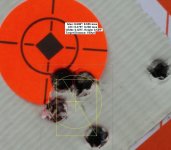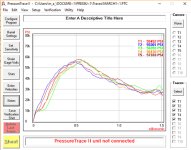stagpanther
New member
It's been a bit of a bumpy road for me coming up to speed with both systems--and I've yet to explore the full potential of what the data actually reveals. It's already very interesting to see how even minute changes in powder charges can result in dramatic changes in the read-outs.
Here are the labradar and Pressure Trace read-outs from today's test of some 6mm creedmoor hand-loads I fired through an AR10 build using 103 eldx bullets and 44.1 grs. of superformance. Except for the one flier--this was the best grouping of the different charges I did--but labradar tagged it as also having one of the highest SD's of the charge weights I did. Might be my poor shooting technique--but charge weights of even .1 gr difference seemed to have dramatically different read-outs and significantly less accuracy. It's also occurred to me that 100 yds might be a bit close for the bullet to fully spin-stabilize--not sure about that.



Here are the labradar and Pressure Trace read-outs from today's test of some 6mm creedmoor hand-loads I fired through an AR10 build using 103 eldx bullets and 44.1 grs. of superformance. Except for the one flier--this was the best grouping of the different charges I did--but labradar tagged it as also having one of the highest SD's of the charge weights I did. Might be my poor shooting technique--but charge weights of even .1 gr difference seemed to have dramatically different read-outs and significantly less accuracy. It's also occurred to me that 100 yds might be a bit close for the bullet to fully spin-stabilize--not sure about that.
Attachments
Last edited:



